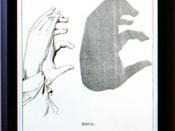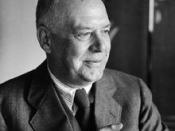Thirteen Ways of Understanding Reality
"Thirteen Ways of Looking at a Blackbird" is about many things and nothing in particular. There is no common thread in it (aside from the blackbirds, which only serve as a common symbol for different things); the poem is chaotic, like nature itself. The main focuses in the poem are imagination, nature, and mainly reality, which are facets of existence that no doubt weighed heavily on Wallace Stevens' mind (as well as anyone else who has a mind to think). In this poem, Stevens ponders a small amount of the intrinsic mystery in reality and attempts to convey his feelings in language. He is successful, and the successful reader will read with an open mind, not a rational brain.
In the first stanza, the only moving thing was the eye of the blackbird; that is to say, a fixed (yet moving, or alive) reference point in an expanse.
This expanse is the mind, the imagination. The only moving thing was a stirring of an idea or emotion. It is the eye (not eyes) of the blackbird, our third eye, if you will, which gives sight into the truest reality that we cannot perceive with the five senses.
I = tree. Minds (ideas) = blackbirds. All blackbirds are pretty much the same, but separate and alive in their own rights. The "three minds" (4) depicted in the second stanza are really just three ideas or notions that Stevens has, which he believes to be so alive and real that he would rather call them minds in their own right. Therefore these ideas in his mind are like blackbirds in a tree: similar yet different, alive and able to "fly" away.
It would seem that the third stanza isn't about internal goings-on in Stevens' mind,


